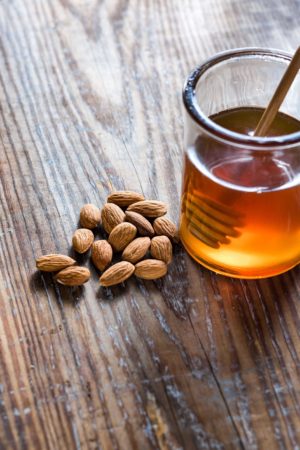
We're not sure about you, but if you ask us, February is a great month! This is the month that encompasses football's biggest game of the season and love's biggest day of the year (aka Valentine's Day). What you may not realize is that right now, honey bees are in California gearing up for the biggest game of their season – the pollination of almonds.
Did you know that California produces 80% of the world's almonds1? And did you also know that almonds are 100% dependent on honey bee pollination? This means that more than 80 billion honey bees are currently buzzing in California getting ready to pollinate the more than 800,000 acres of almond crops, owned by 6,800+ farmers2. Pollinating almonds requires about two honey bee hives per acre, meaning there are upwards of 1.7 million hives – that's approximately 85% of all available commercial hives! Now we know that we just threw a whole bunch of numbers at you, but the point is that honey bees play a major role in the pollination of almonds, and our food supply as a whole.
Many may not know that pollination is the vital "second shift" of the humble honey bee. As the bees fly from one flower to the next, they transfer pollen from the anthers of a flower to the ovules of that or another flower. While other bees, such as the popular bumblebee, butterflies, bats and even birds are all considered pollinators, honey bees are responsible for 80% of insect pollination work. With one in every three bites of food we eat being insect-pollinated, it goes without saying that we have great respect for the work of the ever-busy honey bee.
After a chilly winter, honey bees are trucked over to sunny California in February to prepare for the short almond blooming season that takes place mid-February to mid-March. In most cases, almond pollen is the first natural food source that honey bees encounter. This nutrient-rich food source helps strengthen the hive, which often leads to beekeepers splitting the hive and grow their apiaries (bee farm)3 after the almond bloom.
Recently, The National Honey Board, Almond Board of California, Project Apis m. and CollaborateUp teamed up to illuminate the symbiotic relationship between honey bees and the agricultural industry in the inspiring new documentary “The Job Swap Experiment.” The film puts almond growers and beekeepers in each other’s shoes, offering a firsthand look at what each industry does to protect bees. The film features growers, beekeepers, crop advisors, and hive management advisors, who use their expertise in insects to provide insight into pollinators and all that they do for our food. Check it out below.
From pollinating almonds in California, honey bees will move across the country pollinating other fruits, vegetables, nuts and legumes that we all enjoy.
So while we all take a breath between all the happenings of the month, we invite you to stop and wish good luck to the humble, busy honey bee on the start of their sweet season.
Resources:
1Mother Jones: Almonds Now Require 85 Percent U.S. Beehives, 2015. http://www.motherjones.com/tom-philpott/2015/05/almonds-now-require-85-percent-us-beehives
2Bee Culture: Catch The Buzz – California's Almond Board's Honey Bee Best Management Practices, 2016. http://www.beeculture.com/catch-the-buzz-californias-almond-boards-honey-bee-best-management-practices/
3Almond Board of California: The Buzz On Bees + Almonds, 2015. http://www.almonds.com/sites/default/files/content/attachments/the_buzz_on_bees_almonds.pdf
